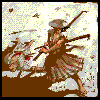
Samurai
CBUB Wins: 3
CBUB Losses: 5
CBUB Ties: 0
Win Percentage: 37.50%
Added by: Ghost Cat
Read more about Samurai at: Wikipedia
Official Site: Public Domain
is the term for the military nobility of pre-industrial Japan. According to translator William Scott Wilson: "In Chinese, the character 侍 was originally a verb meaning to wait upon or accompany a person in the upper ranks of society, and this is also true of the original term in Japanese, saburau. In both countries the terms were nominalized to mean "those who serve in close attendance to the nobility," the pronunciation in Japanese changing to saburai." According to Wilson, an early reference to the word "samurai" appears in the Kokin Wakashū (905–914), the first imperial anthology of poems, completed in the first part of the 9th century.
By the end of the 12th century, samurai became almost entirely synonymous with bushi (武士), and the word was closely associated with the middle and upper echelons of the warrior class. The samurai followed a set of rules that came to be known as Bushidō. While they numbered less than 10% of Japan's population samurai teachings can still be found today in both everyday life and in martial arts such as Kendō, meaning the way of the sword.
Following the Battle of Hakusukinoe against Tang China and Silla in 663 AD that led to Japanese retreat, Japan underwent widespread reform. One of the most important was that of the Taika Reform, issued by Prince Naka no Ōe (Emperor Tenji) in 646 AD. This edict allowed the Japanese aristocracy to adopt the Tang Dynasty political structure, bureaucracy, culture, religion, and philosophy. As part of the Taihō Code, of 702 AD, and the later Yōrō Code, the population was required to report regularly for census, which was used as a precursor for national conscription. With an understanding of how the population was distributed, Emperor Mommu introduced the law whereby 1 in 3–4 adult males were drafted into the national military. These soldiers were required to supply their own weapons, and in return were exempted from duties and taxes. This was one of the first attempts by the Imperial government to form an organized army modeled after the Chinese system. It was called gundan-sei (軍団制) by later historians and is believed to have been short-lived.
The Taihō Code classified most of the imperial bureaucrats into 12 ranks, each divided into two sub-ranks, 1st rank being the highest adviser to the emperor. Those of 6th rank and below were referred to as "samurai" and dealt with day-to-day affairs. Although these "samurai" were civilian public servants, the name is believed to have derived from this term. Military men, however, would not be referred to as "samurai" for many more centuries.
Images with a green border may be set as the character's main profile image (For images 200x200 or 300x300 pixels square).
CBUB Match Record:
| Result | Opponent | My Score | Their Score | |
|---|---|---|---|---|
| Loss | Ninjas | 53 | to | 66 |
| Win | Vikings | 46 | to | 45 |
| Loss | Lu Bu | 36 | to | 54 |
| Loss | The 300 Spartans | 44 | to | 64 |
| Win | The Klingon Empire | 13 | to | 10 |
Fantasy Teams Season 12 Record:
View the historical team line-up
| Result | Opponent | My Score | Their Score | |
|---|---|---|---|---|
| Win | Goblins | 8 | to | 2 |
| Loss | Amazons | 3 | to | 7 |
| Loss | The 300 Spartans | 3 | to | 10 |


